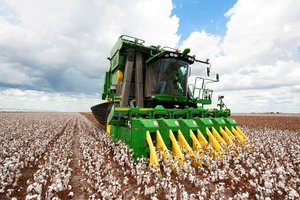
Clemson students are taking their mobile cotton harvester on the road to raise more awareness about agriculture, which currently accounts for more than 212,000 jobs in South Carolina.
Students from Clemson University have redesigned a mechanical cotton picker to teach others about cotton harvesting. They are now taking their project on the road to raise awareness about the process and the agriculture industry as a whole.
“We call this our ‘mobile cotton harvester’,” said Hunter Massey, a lecturer for the Clemson Agricultural Sciences department and director of the initiative. “We plan to take it to high school programs, expos and other events to create awareness about agriculture and our agricultural programs here at Clemson.”
The cotton harvester was built “from the ground up,” according to the students. It includes a monitor, which shows footage of a cotton field. Users can crank up the harvester, engage its heads, turn its spindles, and move cotton up the suction duct. Users can also simulate driving down rows of cotton.
“It was a lot of fun,” said John Platte, a student who wired the cab to its air conditioning system. “I liked being able to apply what I have learned in the classroom. By taking a fabrication class, I knew what tools to use, what the different metals were and things like that. The biggest challenge I faced was having patience. It took a long time, determining what hooks up to what and things like that.”
Click here to see more...